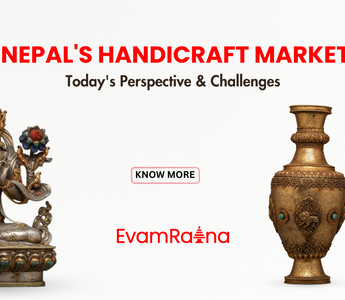Uncovering Nepal's Handicraft Market: Modern Insights and Overcoming Challenges
Nepal's handicraft market is a vibrant reflection of its rich heritage, showcasing intricate artistry in textiles, wood carvings, pottery, and more. These crafts are not only cultural treasures but also vital to the country's economy, providing livelihoods to thousands of artisans, particularly in rural areas. However, as the world rapidly modernizes, the industry faces mounting challenges.
The survival of the industry is threatened by mass-produced items' global competitiveness, restricted access to foreign markets, and younger generations' decreasing interest in traditional crafts. These problems are also made worse by unstable economies, a shortage of raw materials, and a dearth of digital resources.
Opportunities abound in spite of these obstacles. Hope is offered by the growing demand for ethical and sustainable products around the world, digital platforms for market access, and assistance from NGOs or the government. Nepal's craftspeople can overcome challenges and guarantee that their art will continue to flourish and appeal to audiences around the world by embracing innovation and upholding tradition.
The Rich Heritage of Nepalese Handicrafts

Handicrafts form basic parts of Nepal's cultural heritage and national identity. Craft skills in Nepal have been taught from generation to generation both by family members and small close-knit groups. The pieces show Nepal’s past traditions through their design while honoring religious heritage and artistic roots. Through centuries of practice, Nepal's artisans have perfected their expertise in fashioning both Thangka paintings and Tibetan carpets.
Regions like the Kathmandu Valley are celebrated as hubs of artistic brilliance. Bhaktapur, Patan, and Kathmandu itself are home to master craftsmen who continue to produce exceptional works of art. These crafts are not merely decorative but often hold profound spiritual and cultural significance, making them deeply cherished both within and outside Nepal.
The Handicraft Market Today: Opportunities and Global Appeal

In recent years, Nepali handicrafts have garnered significant global attention. People worldwide are seeking authentic, handmade products that tell a story, driven by the rise of conscious consumerism. Nepal’s handicrafts align perfectly with these preferences, as each piece carries with it the essence of a rich culture and a human touch that mass-produced goods cannot replicate.
The export market for Nepalese handicrafts has steadily expanded, with key buyers in countries such as the United States, Europe, and Japan. Products like pashmina shawls, woolen carpets, felt crafts, and silver jewelry have gained immense popularity.
Tourism has also played a pivotal role in boosting the handicraft market. Tourists visiting Nepal are often enchanted by the vibrant markets of Thamel, Bhaktapur, and Patan, where they can purchase authentic handmade products as souvenirs. The global demand for sustainable, eco-friendly goods further positions Nepal’s handicrafts as an appealing choice for consumers seeking ethical alternatives.
However, the opportunities are not without challenges. While the market potential is immense, sustaining the growth of the handicraft industry requires addressing several critical obstacles that threaten its long-term viability.
What distinguishes Nepali artisans and handicrafts?

Some traditional Nepalese handicrafts include metal sculptures, traditional jewelry manufacturing, wood carving, religious and ritual things like bells, vajra, stone sculpture, paintings, pottery, handmade paper, hand knits, and vajra products. Every handcrafted item in Nepal is truly unique. Nepal's traditional handicrafts are distinct from those of other countries. Beautiful wood-carved artwork may be found in all of the Kathmandu Valley's Durbar Palaces. Regarding wood crafts, classic wood carving techniques have been meticulously preserved and documented in medieval writings.
Nepalese artisans use specialized talents and relatively little machinery to create their goods. Every product represents its history, culture, and legacy despite having radically different features. Additionally, these handicrafts convey the closeness of individuals to nature and ethnic beliefs. All things considered, Nepali craftsmen and handicrafts contribute to the preservation of the nation's history and culture, thereby reducing poverty and fostering cultural diversity.
Since Nepal is a collectivistic society, parents are expected to live with their youngest son or sons. Additionally, a family that owns a handicraft company or values art encourages their child or children to pursue artisanship and acquire that special touch. Unfortunately, contemporary Nepalese artists lack the skills of older masters or specialists who created their pieces without the usage of glue or nails.
Challenges Faced by Nepal’s Handicraft Industry
Despite its rich heritage, cultural significance, and global appeal, Nepal’s handicraft industry is grappling with numerous challenges that prevent it from reaching its full potential. This industry, which has been a cornerstone of Nepal’s identity for centuries, faces mounting pressures in today’s fast-paced and competitive world. The artisans—the backbone and soul of this sector—are particularly affected, struggling with a range of issues. From limited access to essential resources such as quality raw materials and advanced tools to insufficient financial support, their craft often becomes a labor of survival rather than one of growth and innovation. Adding to these struggles are the pressures of modern-day competition, where machine-made and mass-produced goods often dominate the market, undercutting the value of authentic handmade products. These challenges not only threaten the livelihoods of artisans but also endanger the preservation of Nepal’s rich artistic traditions.
1. Limited Access to Resources and Training
Nepalese artisans struggle to develop their skills because they cannot obtain basic equipment along with proper materials and instruction. For instance, master craftspeople who make handwoven carpets or brass sculptures depend heavily on traditional production methods, which take longer and work less productively. Small-scale producers find it hard both to increase production output and keep product standards high when they lack access to current production methods.
2. Declining Interest Among Younger Generations
Another major challenge is the declining interest in handicrafts among younger generations. Many young people in Nepal are drawn to other career opportunities, perceiving handicraft work as less lucrative and labor-intensive. This generational shift poses a threat to the continuity of traditional craftsmanship, as fewer young artisans are willing to carry on the legacy.
3. Competition from Mass-Produced Goods
The rise of mass-produced goods poses a significant threat to Nepal’s handicraft market. Cheaper, machine-made products often flood markets, offering lower prices that many consumers find hard to resist. This competition makes it challenging for handmade goods, which require time, skill, and effort, to compete on price.
However, there is hope in the growing demand for authentic, handmade, and sustainable products. Enterprises like Our Handicraft have focused on emphasizing the uniqueness and authenticity of Nepalese crafts, educating consumers about the value of supporting artisans and purchasing ethically-made goods.
4. Limited Marketing and Branding
While Nepalese handicrafts are globally admired, the lack of effective marketing and branding has hindered their visibility in international markets. Many artisans and small businesses struggle to create compelling narratives around their products or reach a wider audience. Without strong branding, it becomes difficult to differentiate their work from competitors.
Through these efforts, consumers are not only purchasing a product but also forming an emotional connection with the artisans and their craft. This deeper appreciation adds significant value to the handicrafts, transforming them into meaningful pieces that reflect both artistry and culture. By humanizing the process and sharing the stories behind the creations, we are helping to foster respect, awareness, and a stronger market for Nepal’s handicrafts.
The Role of Organizations in Reviving Nepal’s Handicraft Industry

We, for instance, works closely with local artisans to ensure they receive fair compensation for their work. By eliminating exploitative practices and providing a platform for artisans to showcase their talents, we are helping to uplift entire communities. Similarly, Our Handicrafts focuses on creating opportunities for artisans to connect with global markets, enabling them to earn a sustainable livelihood while preserving their craft.
Through initiatives like training programs, resource distribution, and marketing support, these organizations are addressing some of the most pressing challenges facing Nepal’s handicraft industry. They are also fostering a sense of pride and ownership among artisans, ensuring that the rich heritage of Nepalese craftsmanship continues to thrive.
The Way Forward: Sustaining Nepal’s Handicraft Legacy
To ensure the long-term success of Nepal’s handicraft market, it is essential to adopt a multi-faceted approach that addresses the needs of artisans, promotes fair trade, and adapts to changing consumer preferences.
Efforts must also be made to encourage the younger generation to take an active interest in crafts. By integrating traditional crafts into educational programs, offering apprenticeships, and creating financial incentives, it is possible to inspire a new wave of artisans who carry forward Nepal’s legacy.
Additionally, leveraging digital platforms can significantly enhance the visibility of Nepali crafts. Through e-commerce websites, social media campaigns, and virtual exhibitions, artisans can reach a global audience and showcase the unique value of their work. Storytelling, in particular, is a powerful tool that can help consumers connect emotionally with the crafts and the people behind them.
A Future Rooted in Tradition and Innovation

Nepal’s handicraft market stands as a powerful testament to the resilience, creativity, and cultural richness of its people. It embodies centuries of tradition and artistic expression, each piece telling a story of identity and heritage. Despite facing numerous challenges such as limited resources, market competition, and shifting consumer preferences, the industry holds immense potential for growth and transformation. By striking the right balance between preserving tradition and embracing innovation, Nepal has the opportunity to not only safeguard its rich cultural legacy but also adapt to the evolving demands of a globalized world.
As consumers, businesses, and policymakers rally together to support this vital sector, the future of Nepal’s handicraft industry looks promising. By fostering innovation, promoting ethical practices, and celebrating the unmatched beauty of handmade goods, Nepal’s artisans can continue to inspire, captivate, and share their stories with the world for generations to come.
Final Thoughts
In conclusion, the handicraft market of Nepal showcases centuries of traditional cultural heritage through handcrafted creations people have admired around the world. Despite its worldwide attractiveness and financial success, the industry deals with important barriers such as resource scarcity, market entry problems and increasing machine-made goods competition. The difficulties damage both Nepali artisans' work opportunities and the traditional cultural heritage they protect.
Yet, there is hope. Through digital marketing and business innovation combined with NGO and government backing, Nepal's artisans can grow their success. Through combined action and dedication to saving traditional methods, the handicraft sector will survive while sharing Nepal's heritage with future generations.















